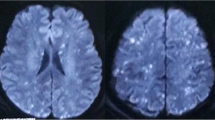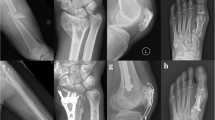Abstract
Fat embolism syndrome (FES) is a rare syndrome caused by embolization of fat particles into multiple organs including the brain. It typically manifests with petechial rash, deteriorating mental status, and progressive respiratory insufficiency, usually occurring within 24–48 h of trauma with long-bone fractures or an orthopedic surgery. The diagnosis of FES is based on clinical and imaging findings, but requires exclusion of alternative diagnoses. Although there is no specific treatment for FES, prompt recognition is important because it can avoid unnecessary interventions and clarify prognosis. Patients with severe FES can become critically ill, but even comatose patients with respiratory failure may recover favorably. Prophylactic measures, such as early stabilization of fractures and certain intraoperative techniques, may help decrease the incidence and severity of FES.



Similar content being viewed by others
References
Talbot M, Schemitsch EH. Fat embolism syndrome: history, definition and epidemiology. Injury. 2006;375:53–7.
Fuide GW, Harrison P. Fat embolism: a review. Arch Emerg Med. 1991;8:233–9.
Shaikh N. Emergency management of fat embolism syndrome. J Emerg Trauma Shock. 2009;2:29–33.
Robert JH, Hoffmeyer P, Broquet PE, Cerutti P, Vasey H. Fat embolism syndrome. Orthop Rev. 1993;22:567–71.
DeFroda SF, Klinge SA. Fat embolism syndrome with cerebral fat embolism associated with long-bone fracture. Am J Orthop. 2016;45:E515–21.
Aman J, van Koppenhagen L, Snoek AM, van der Hoeven JG, van der Lely AJ. Cerebral fat embolism after bone fractures. Lancet. 2015;386:e16.
Mijalski C, Lovett A, Mahajan R, Sundararajan S, Silverman S, Feske S. Cerebral fat embolism. A case of rapid onset coma. Stroke. 2015;46:e251–3.
Jacobson DM, Terrence CF, Reinmuth OM. The neurologic manifestations of fat embolism. Neurology. 1986;36:847–51.
Kellogg RG, Fontes RBV, Lopes DK. Massive cerebral involvement in fat embolism syndrome and intracranial pressure management. J Neurosurg. 2013;119:1263–70.
Parizel PM, Demey HE, Veeckmans G, Verstreken F, Cras P, Jorens PG, De Schepper AM. Early diagnosis of cerebral fat embolism syndrome by diffusion-weighted MRI (Starfield pattern). Stroke. 2001;32:2942–4.
Suh SI, Seol HY, Seo WK, Koh SB. Cerebral fat embolism: susceptibility-weighted magnetic resonance imaging. Arch Neurol. 2009;66:1170.
Bulger EM, Smith DG, Maier RV, et al. Fat embolism syndrome. A 10-year review. Arch Surg. 1997;132(435):439.
Pell AC, Christie J, Keating JF, et al. The detection of fat embolism by transoesophageal echocardiography during reamed intramedullary nailing. A study of 24 patients with femoral and tibial fractures. J Bone Joint Surg Br. 1993;75(921):925.
Mellor A, Soni N. Fat embolism. Anesthesia. 2001;56:145–54.
Gurd AR, Wilson RI. The fat embolism syndrome. J Bone Joint Surg Br. 1974;56B(408):416.
Fabian TC, Hoots AV, Stanford DS, et al. Fat embolism syndrome: prospective evaluation in 92 fracture patients. Crit Care Med. 1990;18(42):46.
Lee SC, Yoon JY, Nam CH, Kim TK, Jung KA, Lee DW. Cerebral fat embolism syndrome after simultaneous bilateral total knee arthroplasty. J Arthroplast. 2012;27:409–14.
Akhtar S. Fat embolism. Anesthesiol Clin. 2009;27:533–50.
Gauss H. The pathology of fat embolism. Arch Surg. 1924;9(592):605.
Lehman EP, Moore RM. Fat embolism, including experimental production without trauma. Arch Surg. 1927;14(621):662.
Kamenar E, Burger PC. Cerebral fat embolism: a neuropathological study of a microembolic state. Stroke. 1980;11:477–84.
Simon AD, Ulmer JL, Strottmann JM. Contrast-enhanced MR imaging of cerebral fat embolism: case report and review of the literature. Am J Neuroradiol. 2003;24:97–101.
Curtis AM, Knowles GD, Putman CE, McLoud TC, Ravin CE, Smith GJ. The three syndromes of fat embolism: pulmonary manifestations. Yale J Biol Med. 1979;52:149–57.
George J, George R, Dixit R, Gupta RC, Gupta N. Fat embolism syndrome. Lung India. 2013;30:47–53. doi:10.4103/0970-2113.106133.
Gupta A, Reilly ChS. Fat embolism. Cont Edu Anaesth Crit Care Pain. 2007;7:148–51.
Mittal MK, Burrus TM, Campeau NG, Eckel LJ, Rabinstein AA, Wijdicks EF. Pearls & oy-sters: good recovery following cerebral fat embolization with paroxysmal hyperactivity syndrome. Neurology. 2013;81:e107–9.
Lump D, Moyer M. Paroxysmal sympathetic hyperactivity after severe brain injury. Curr Neurol Neurosci Rep. 2014;14:494.
Hughes JD, Rabinstein AA. Early diagnosis of paroxysmal sympathetic hyperactivity in the ICU. Neurocrit Care. 2014;20:454–9.
Baguley IJ, Heriseanu RE, Cameron ID, Nott M, Slewa-Younan S. A critical review of the pathophysiology of dysautonomia following traumatic brain injury. Neurocrit Care. 2008;8:293–300.
Rabinstein AA, Benarroch EE. Treatment of paroxysmal sympathetic hyperactivity. Curr Treat Options Neurol. 2008;10:151–7.
Gurd AR, Wilson RI. The fat embolism syndrome. J Bone Joint Surg Br. 1974;56B:408.
Gurd AR. Fat embolism: and aid to diagnosis. J Bone Joint Surg Br. 1970;52:732.
Schonfeld SA, Ploysongsang Y, Di Lisio R, Crissman JD, Miller E, Hammerschmidt DE, et al. Fat embolism prophylaxis with corticosteroid. A prospective study in high-risk patients. Ann Int Med. 1983;99:438–43.
Chan KM, Tham KT, Chiu HS, et al. Post-traumatic fat embolism—its clinical and subclinical presentations. J Trauma. 1984;24:45–9.
Peltier LF. Fat embolism. An appraisal of the problem. Clin Orthop Relat Res. 1984;187:3–17.
Roger A, Xaubet C, Agustν E, Zabala E, Ballester A. Torres Role of bronchoalveolar lavage in diagnosis of fat embolism syndrome. Eur Respir J. 1995;8:1275–80.
Mimoz O, Edouard A, Beydon L, Quillard J, Verra F, Fleury J, et al. Contribution of bronchoalveolar lavage to the diagnosis of posttraumatic pulmonary fat embolism. Intensive Care Med. 1995;21:973–80.
Van den Brande FG, Hellemans S, De Schepper A, De Paep R, Op de Beeck B, De Raeve HR, et al. Post-traumatic severe fat embolism syndrome with uncommon CT findings. Anaesth Intensive Care. 2006;34:102–6.
Sakamoto T, Sawada Y, Yukioka T, et al. Computed tomography for diagnosis and assessment of cerebral fat embolism. Neuroradiology. 1983;24:283–5.
Chrysikopoulos H, Maniatis V, Pappas J, et al. Case report: posttraumatic cerebral fat embolism: CT and MR findings—report of two cases and review of the literature. Clin Radiol. 1996;51:728–32.
Takahashi M, Suzuki R, Osakabe Y, Asai JI, Miyo T, Nagashima G, et al. Magnetic resonance imaging findings in cerebral fat embolism: correlation with clinical manifestations. J Trauma. 1999;46:324–7.
Ryu CW, Lee DH, Kim TK, Kim SJ, Kim HS, Lee JH, et al. Cerebral fat embolism: diffusion-weighted magnetic resonance imaging findings. Acta Radiol. 2005;46:528–33.
Eguia P, Medina A, Garcia-Monco JC, Martin V, Monton FI. The value of diffusion-weighted MRI in the diagnosis of cerebral fat embolism. J Neuroimaging. 2007;17:78–80.
Rughani AI, Florman JE, Seder D. Clinical and radiographic improvement following cerebral fat emboli. Neurocrit Care. 2011;15:190–3.
Stoeger A, Daniaux M, Feiber S, Stockhammer G, Aichner F, Zur Nedden D. MRI findings in cerebral fat embolism. Eur Radiol. 1998;8:1590–3.
Pinney SJ, Keating JF, Meek RN. Fat embolism syndrome in isolated femoral fractures: does timing of nailing influence incidence? Injury. 1998;29:131–3.
Forteza AMI, Koch S, Campo-Bustillo I, Gutierrez J, Haussen DC, Rabinstein AA, Romano J, Zych GA, Duncan R. Transcranial Doppler detection of cerebral fat emboli and relation to paradoxical embolism: a pilot study. Circulation. 2011;123:1947–52.
Bederman SS, Bhandari M, McKee MD, Schemitsch EH. Do corticosteroids reduce the risk of fat embolism syndrome in patients with long-bone fractures? A meta-analysis. Can J Surg. 2009;52:386–93.
Bein T, Grasso S, Moerer O, Quinter M, Guerin C, Deja M, et al. The standard of care of patients with ARDS: ventilatory settings and rescue therapies for refractory hypoxemia. Intensive Care Med. 2016;42:699–711.
Narendra DK, Hess DR, Sessler CN, Belete HM, Guntupalli KK, Khusid F et al. Update in management of severe hypoxemic respiratory failure. Chest. 2017.
Ventetuolo CE, Klinger JR. Management of acute right ventricular failure in the intensive care unit. Ann Am Thorac Soc. 2014;11:811–22.
Kholdani CA, Fares WH. Management of right heart failure in the intensive care unit. Clin Chest Med. 2015;36:511–20.
Author information
Authors and Affiliations
Corresponding author
Ethics declarations
Conflicts of interest
All the authors declare that they have no conflict of interest.
Rights and permissions
About this article
Cite this article
Godoy, D.A., Di Napoli, M. & Rabinstein, A.A. Cerebral Fat Embolism: Recognition, Complications, and Prognosis. Neurocrit Care 29, 358–365 (2018). https://doi.org/10.1007/s12028-017-0463-y
Published:
Issue Date:
DOI: https://doi.org/10.1007/s12028-017-0463-y




